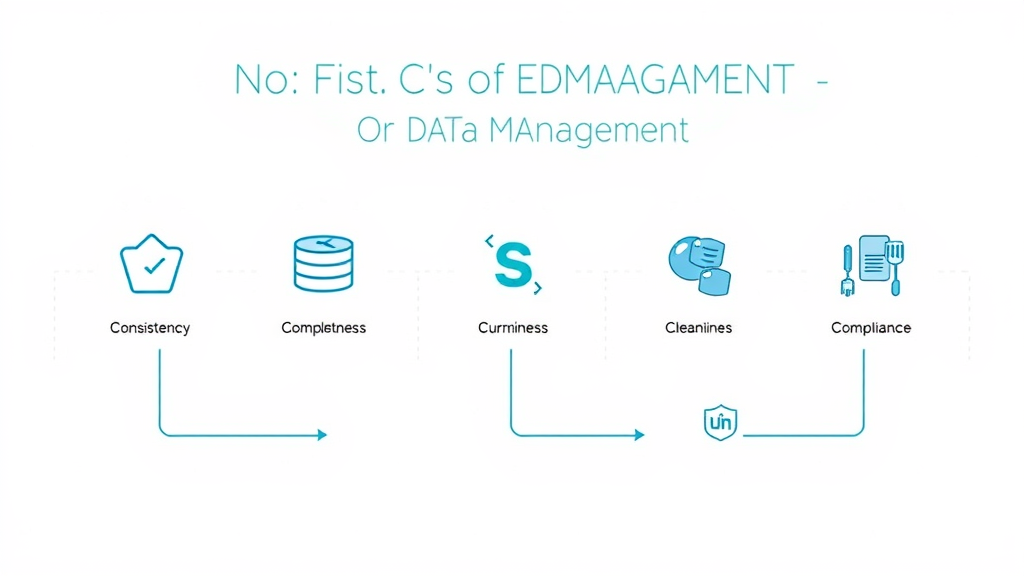Did you know that nonprofit organizations using robust data management strategies are 30% more likely to exceed their fundraising goals? In today’s fast-paced, mission-driven environment, managing your nonprofit’s data isn’t just about compliance or organization—it can be the difference between surviving and thriving. Whether you’re struggling to keep track of donor information, optimize fundraising campaigns, or measure impact, the power of data management in nonprofit organizations is a game-changer. This guide will help you unlock tools, strategies, and practical solutions to fix your data management system—starting now.
Unlocking the Power of Data Management in Nonprofit Organizations: Surprising Facts and Statistics
The power of data in nonprofit organizations goes far beyond mere record-keeping. According to sector-wide studies, less than 50% of nonprofits actively use their data analytics to make informed decisions, even though organizations that leverage data management tools regularly enjoy significantly better donor retention and operational efficiency. By focusing on proven nonprofit data management techniques, nonprofit leaders can track donor activity, optimize volunteer contributions, and report outcomes far more effectively. Enhanced data governance not only improves daily workflow but also dramatically increases the credibility and transparency of your mission.
Effective data management in nonprofit organizations helps avoid costly mistakes—like data entry errors that can impact everything from donor database accuracy to compliance and privacy safeguards. With more digital fundraising campaigns and increased collection of relevant data, the need for better donor data tracking and flexible management systems has never been greater. If you’re ready to unlock the potential within your nonprofit data and empower staff to make informed decisions, read on for actionable insights and best practices.

"Nonprofit organizations that use robust data management strategies are 30% more likely to exceed fundraising goals."
What You’ll Learn About Data Management in Nonprofit Organizations
- Key principles guiding data management in nonprofit organizations
- How to structure donor data and volunteer management effectively
- Implementation steps for nonprofit data management systems and analytics
- Best practices in data governance, reporting, and data analytics
- Common challenges nonprofits face and how to overcome them
Understanding the Importance of Data Management in Nonprofit Organizations
Data management in nonprofit organizations is about far more than compliance or administrative efficiency. It’s a strategic asset that enables every nonprofit leader to make informed decisions about fundraising, donor relations, and program outcomes. Organizations that invest in reliable nonprofit data management systems report fewer data breaches, healthier donor relationships, and a greater ability to track donor habits over time. This single area of nonprofit management has cascading effects on revenue generation, stewardship, and organizational reputation.
Often, the greatest barrier to effective nonprofit data management is a lack of clarity about why it matters. Beyond protecting against data entry mistakes or loss of donor information, a strong management system is your nonprofit’s roadmap for operational efficiency. It supports impactful fundraising campaigns, smooths volunteer management, and provides relevant data you can trust during audits or reporting cycles. Nonprofit CRM and other data management tools are now more accessible and crucial than ever for organizations seeking to achieve their mission at scale.

Why Data Management Matters for Nonprofit Organizations
The ability to track donor interactions, volunteer hours, and program impact hinges on how well a nonprofit organization manages its data. Growth depends on quick access to donor database records, precise data analytics for campaign planning, and ironclad data governance for donor privacy. Nonprofit leaders who understand the value of relevant data can propel their missions forward—raising more funds, retaining more donors, and lasting through changing regulatory environments. Ultimately, well-managed nonprofit data turns every data point into an opportunity for greater community impact and organizational sustainability.
As nonprofits expand digital outreach and support, data management becomes critical for storing donor information and securely managing sensitive volunteer data. Strong systems also enhance reporting tools for transparency with stakeholders and grantors. In an era where donor trust is paramount, your approach to data—how you record, store, and protect it—has immediate and long-term consequences for your reputation and fundraising outcomes.
The Impact of Effective Nonprofit Data Management on Success
Nonprofit organizations that deploy effective nonprofit data management experience drastic improvements in operational efficiency and strategic oversight. With comprehensive donor data at their fingertips, nonprofit leaders can tailor communications, launch more successful fundraising campaigns, and improve donor retention by personalizing outreach. Volunteer management becomes seamless—matching people to initiatives based on skills and previous involvement, using the same central data repository.
Moreover, sophisticated data analytics and reporting tools can reveal trends, opportunities, and risks that would otherwise go unnoticed. By implementing smart data governance frameworks, organizations can protect against data breaches and compliance infractions, cementing donor trust and fostering a data-driven culture. This leads to more accountable, transparent, and ultimately more successful nonprofit management overall.
Key Concepts and Principles: Data Management in Nonprofit Organizations
To build a strong foundation for data management in nonprofit organizations, understanding core concepts is essential. Robust systems begin with clean, structured data and are reinforced by consistent maintenance and compliance. Whether tracking donor information or launching new data analytics initiatives, every organization needs universal principles to guide their processes and ensure data integrity.
One essential concept is that data should be complete, accurate, and accessible at the point of need—whether by fundraising managers, nonprofit leaders, or data entry staff. Nonprofit CRM solutions, donor database platforms, and modern reporting tools are all shaped by underlying best practices. Implementing consistent standards fuels better donor relations, strengthens volunteer management, and safeguards your ability to make informed decisions. In a field where every dollar and volunteer minute counts, these principles set high-performing organizations apart.
The 5 C's of Data Management for Nonprofit Organizations
The backbone of effective data management in nonprofit organizations is captured by the five C’s: Consistency, Completeness, Currency, Cleanliness, and Compliance. These pillars ensure that every data management tool—from donor database to volunteer management software—delivers value you can trust. Consistency provides uniformity across records, reducing confusion and data entry errors. Completeness means capturing every relevant data point, from donor information to volunteer service logs.
Currency is about keeping your nonprofit data up to date, ensuring every record is timely and actionable. Cleanliness addresses the removal of duplicates, outdated contacts, or incorrect donation amounts that can pollute donor databases. Finally, Compliance keeps your nonprofit safe from privacy violations and legal complications, especially when handling sensitive donor and volunteer information. By embedding the five C’s in your workflow, your organization will strengthen fundraising campaigns and overall nonprofit management.
Types of Data Management Solutions in Nonprofit Organizations
There’s no “one-size-fits-all” when it comes to nonprofit data management. Solutions range from cloud-based nonprofit CRM systems designed for fundraising and donor relations to specialized data management tools that automate volunteer scheduling, donor acknowledgments, and reporting. Some nonprofits maximize the power of data through simple spreadsheet-based donor databases, while larger organizations might use comprehensive donor management software linked to real-time analytics and reporting tools.
Choosing the right management system depends on your resources, staff expertise, and the complexity of your donor and volunteer landscapes. As your nonprofit grows, so should your data management approach—shifting from manual data entry to integrated systems that update donor databases in real-time, offer predictive analytics for campaigns, and automate compliance checks for donor data security. By evaluating and evolving your technology stack, you’ll better support nonprofit leaders and ensure data-driven growth.

Core Components: Donor Data, Volunteer Management, and Nonprofit CRM
Effective data management in nonprofit organizations pivots on three core components: donor data, volunteer management, and the use of a nonprofit CRM. Together, these pillars guide strategy, strengthen donor relationships, and optimize operational processes. A well-maintained donor database ensures that fundraising efforts are targeted and donor retention rates stay high. Volunteer management systems streamline scheduling and engagement, and nonprofit CRMs tie everything together for a holistic view of your organization’s activity.
A strong nonprofit leader ensures all three pieces are not only in place but also fully integrated. This enables more reliable reporting, better analysis of fundraising campaigns, and surfacing of trends that fuel sustainable growth. By bringing these core elements under one data management umbrella, organizations can act quickly, avoid errors, and create a consistent donor and volunteer experience, all while solidifying compliance and data security.
Donor Data and Donor Database Best Practices
At the heart of every successful fundraising campaign is a clean, organized, and accessible donor database. Managing donor data isn’t just about storing contact information—it’s about understanding donor behaviors, tracking donation amounts, and mapping engagement over time for better donor relations. The best nonprofit data management tools enable easy segmentation, streamlined acknowledgment workflows, and secure storage of sensitive information.
Best practices include regular data cleaning, prompt data entry after every interaction, and making use of customizable nonprofit CRM fields for things like giving history, volunteerism, and donor communication preferences. Nonprofit leaders should routinely audit their donor databases for duplicates or outdated records, ensuring their outreach is as effective and personal as possible. Robust reporting tools built into donor management software help turn raw data into actionable intelligence, driving both day-to-day efficiency and long-term strategic planning.

How Volunteer Management Strengthens Nonprofit Data Management
Volunteer management is another cornerstone of nonprofit data management and operational efficiency. Modern systems let nonprofit organizations track volunteer hours, skills, event participation, and even training milestones—all in one place. This holistic view is invaluable for recognizing outstanding efforts, matching volunteer talents with organizational needs, and reporting real impact to stakeholders.
Integrating volunteer management with a central donor database provides nonprofit leaders with a complete snapshot of supporter engagement. Not only does this approach foster a sense of belonging for volunteers, but it also uncovers cross-over opportunities—like cultivating volunteers into donors. Streamlining data entry, automating scheduling, and using reporting tools for program evaluation all contribute to a more productive, motivated, and data-driven volunteer force.
Nonprofit CRM and Data Analytics Tools
The right nonprofit CRM does far more than serve as a digital address book—it’s a strategic command center for data analytics and donor stewardship. A modern CRM enables nonprofit staff to log every touchpoint with donors, volunteers, and partners, while robust analytics and reporting dashboards show which fundraising campaigns are most effective or where engagement might be falling short.
Advanced data analytics tools empower organizations to forecast giving trends, evaluate program impact, and make informed decisions in real-time. Whether tracking donor retention rates, mapping volunteer engagement, or setting up automated communications, nonprofit CRMs with built-in reporting tools streamline every facet of nonprofit management. The best systems are also scalable, adapting to both small grassroots organizations and large, multi-chapter nonprofits.
Implementing a Data Management System in Nonprofit Organizations
Implementing a robust data management system can seem overwhelming, but breaking it into manageable steps ensures every facet of your nonprofit organization benefits. Begin by assessing your current data management capabilities: Where are you excelling, and what are your pain points—data entry, donor data quality, volunteer recordkeeping, or reporting tools? From there, select the right data management tools for your nonprofit, balancing ease of use, integration needs, and budget.
The next phase involves setting up and customizing your donor database and nonprofit CRM. This means migrating historical data, segmenting donors, and linking every element to fundraising and volunteer management workflows. Finally, formalize your processes with data governance standards and provide comprehensive training to both nonprofit leaders and line staff. The result? Streamlined operations, better analytics, and a unified approach to nonprofit data management across the organization.
- Assess Current Data Management Capabilities
- Select the Right Nonprofit Data Management Tools
- Set Up Donor Database and CRM Systems
- Implement Data Governance Standards
- Train Nonprofit Leaders and Staff on Best Data Practices
| System | Donor Database | Volunteer Management | Data Analytics | Reporting Tools | Security & Compliance |
|---|---|---|---|---|---|
| Bloomerang | ✔ Robust | ✔ Integrated | ✔ Visual Dashboards | ✔ Automated | ✔ High |
| Salesforce Nonprofit Success Pack | ✔ Customizable | ✔ Add-ons | ✔ Predictive Analytics | ✔ Advanced | ✔ High |
| Kindful | ✔ Intuitive | ✔ Basic | ✔ Standard | ✔ Export Options | ✔ Moderate |
| Neon CRM | ✔ All-in-one | ✔ Event Focused | ✔ Embedded | ✔ Customizable | ✔ High |
Ensuring Data Governance and Security in Nonprofit Data Management
Safeguarding donor data and ensuring data governance are top priorities for modern nonprofits. With increased risks of data breaches and privacy concerns, nonprofit leaders must implement clear protocols and compliant management systems. Sound data governance sets the rules for how data is collected, stored, accessed, and discarded—protecting donor databases and volunteer records from unauthorized use and compliance violations.
Security measures—such as role-based access, encryption, and regular audits—fortify your nonprofit data management efforts. Staff training plays a pivotal role in avoiding accidental leaks or unauthorized sharing. By making security and governance part of your organizational culture, you reinforce donor trust, support regulatory compliance, and ensure your nonprofit organization is prepared for both today’s and tomorrow’s data challenges.

Best Practices for Data Governance in Nonprofit Organizations
Data governance in nonprofit organizations should start with a written policy outlining acceptable use, data entry standards, retention schedules, and breach response plans. Nonprofit leaders should establish clear chains of responsibility, so everyone—from board members to new staff—understands their role in safeguarding nonprofit data. Regularly updating data governance documentation after system or regulation changes ensures compliance and operational reliability.
Periodic reviews and audits are equally important. Use reporting tools to flag anomalies or unauthorized access, and provide ongoing training to adapt to evolving standards. Many organizations find success by appointing a data governance lead—a champion responsible for oversight and continual improvement. The overarching goal: build a culture where every donor interaction, volunteer engagement, and fundraising campaign strengthens your organization’s data integrity.
Securing Sensitive Donor Data and Volunteer Information
Confidence in your nonprofit’s stewardship starts with data security. Employ encrypted donor databases and secure volunteer management portals to minimize risk. Limit access to sensitive data using tiered permissions and require strong authentication for nonprofit CRM and analytics dashboards. This not only protects donor information but complies with regulations around donor privacy, such as GDPR or CCPA where applicable.
Data security also demands strong day-to-day habits, like prompt data entry, careful sharing of login credentials, and regularly updating passwords and systems. In case of a breach, clear incident response protocols help nonprofits respond quickly and transparently. By making data security a visible priority, nonprofit organizations show donors, staff, and the public that privacy and integrity are as central as any fundraising initiative or community program.
Driving Performance: Analytics and Reporting in Nonprofit Organizations
One of the most valuable outcomes of data management in nonprofit organizations is actionable insight—delivered through sophisticated data analytics and reporting tools. These solutions transform donor data, volunteer metrics, and program stats into visual dashboards and timely reports, empowering nonprofit leaders to refine strategy, streamline operations, and justify funding requests with evidence-based narratives.
Analytics and reporting go hand in hand with nonprofit management. Whether tracking fundraising campaigns, volunteer engagement, or beneficiary outcomes, quick access to relevant data allows for rapid responses and continuous improvement. Prioritizing analytics not only boosts operational efficiency but also fosters a culture of informed decision-making at every level of your organization.

Data Analytics and Reporting Tools for Nonprofit Management
Modern data analytics tools help nonprofit organizations filter through massive sets of donor data, volunteer records, and event histories to highlight trends and opportunities. Solutions like Tableau, Microsoft Power BI, or embedded nonprofit CRM analytics provide real-time insights on donor retention, average donation amount, and the effectiveness of outreach campaigns.
These platforms allow for customization—tailoring dashboards for specific needs such as board reports or grant applications. The result is a faster time to insight, enabling organizations to fine-tune fundraising campaigns or volunteer initiatives quickly. By leveraging analytics and reporting tools, nonprofits transform raw data into strategy—all while reducing manual tracking and freeing up staff resources for mission-critical work.
How Analytics Drive Operational Efficiency and Fundraising Campaigns
Analytics provide a roadmap for nonprofit leaders to measure success and identify areas for improvement. Automated dashboards show which fundraising campaigns generated the highest returns, which donors need additional stewardship, and where operational efficiency can be increased. When data management systems feed accurate, timely analytics, course correction becomes easier and less risky.
Applying data analytics to campaign targeting, event planning, and regular communications means resources are invested where they are most likely to perform. Nonprofit management teams that base decisions on up-to-date, relevant data consistently see higher fundraising outcomes and more robust volunteer engagement. From resource allocation to board impact reporting, analytics-driven organizations are simply better positioned to fulfill their missions.
People Also Ask: Data Management in Nonprofit Organizations

What are the 5 C's of data management?
Answer: The 5 C's represent the pillars for data management: Consistency, Completeness, Currency, Cleanliness, and Compliance. For nonprofit organizations, adhering to these principles ensures data accuracy and legal integrity.
What are the four types of data management?
Answer: The four types involve master data management, metadata management, reference data management, and data governance—all essential for nonprofit organizations to structure reliable databases.
What is the common data model for nonprofits?
Answer: A common data model for nonprofits includes components for donor information, volunteer records, fundraising campaigns, and program impacts—interconnected for optimal reporting and decision-making.
What are the 5 steps to data management?
Answer: Collection, Storage, Management, Analysis, and Reporting. Each step is vital in creating a robust data management environment for nonprofit organizations.
Challenges and Solutions: Data Management in Nonprofit Organizations
Despite the benefits, many nonprofit organizations face ongoing challenges in deploying, maintaining, and upgrading their data management systems.
- Overcoming limited budgets for advanced data management systems
- Mitigating staff training challenges in nonprofit management
- Ensuring ongoing data governance and privacy compliance
- Adapting to changing data analytics and reporting standards
Budget constraints may lead organizations to rely on outdated donor databases or patchwork systems that are prone to data entry errors. To overcome these hurdles, nonprofits can explore affordable management tools designed specifically for small organizations, seek out volunteer IT support, or spread implementation costs over multiple fiscal years. For staff training, regularly scheduled workshops and appointing internal data champions foster buy-in and keep nonprofit leaders and staff at the forefront of data management best practices.

Key Takeaways: Optimizing Data Management in Nonprofit Organizations
- Invest in scalable nonprofit data management solutions
- Prioritize donor data privacy and robust volunteer management
- Leverage nonprofit CRM and analytics for growth
- Foster a culture of accuracy, security, and data-driven decision-making
Frequently Asked Questions: Data Management in Nonprofit Organizations
How can small nonprofit organizations start data management?
Small nonprofits can start by identifying core data needs (such as a basic donor database and volunteer tracking), using free or affordable nonprofit CRM solutions, and establishing simple data governance policies to maintain accuracy and compliance as they grow.
What are the best nonprofit CRM solutions for donor data?
Popular choices include Bloomerang, Salesforce Nonprofit Success Pack, Kindful, and Neon CRM. These platforms offer scalable donor data management, integrated analytics, and robust reporting tools tailored for the nonprofit sector.
How does data management improve fundraising campaigns?
Effective nonprofit data management provides up-to-date donor information, accurate segmentation, and targeted communications. This enables more personalized outreach, higher donor retention, and maximized campaign impact through real-time analytics and trend tracking.
Conclusion: Take Control of Data Management in Nonprofit Organizations Today
Unlock your nonprofit organization’s potential by investing in smarter data management. Your mission’s impact—and sustainability—depend on it.
"By optimizing data management in nonprofit organizations, leaders not only streamline operations but maximize their mission’s impact."
Ready to Transform Your Nonprofit’s Data Management? Call me the Chaplain 786-333-5270
To enhance your understanding of data management in nonprofit organizations, consider exploring the following resources:
-
“A Guide to Nonprofit Data Management Best Practices”: This article outlines essential strategies for nonprofits, including the adoption of centralized databases like OneDrive and SharePoint, regular data audits, and robust security measures to protect sensitive information. (qlicnfp.com)
-
“A Guide to Nonprofit Data Management and Compliance”: This resource emphasizes the importance of aligning data management with organizational goals, selecting scalable tools, and fostering a data-driven culture to enhance operational efficiency and mission impact. (fluxx.io)
By delving into these guides, you’ll gain actionable insights to optimize your nonprofit’s data management practices, ensuring compliance, security, and strategic alignment with your mission.
 Add Row
Add Row  Add
Add 




Write A Comment